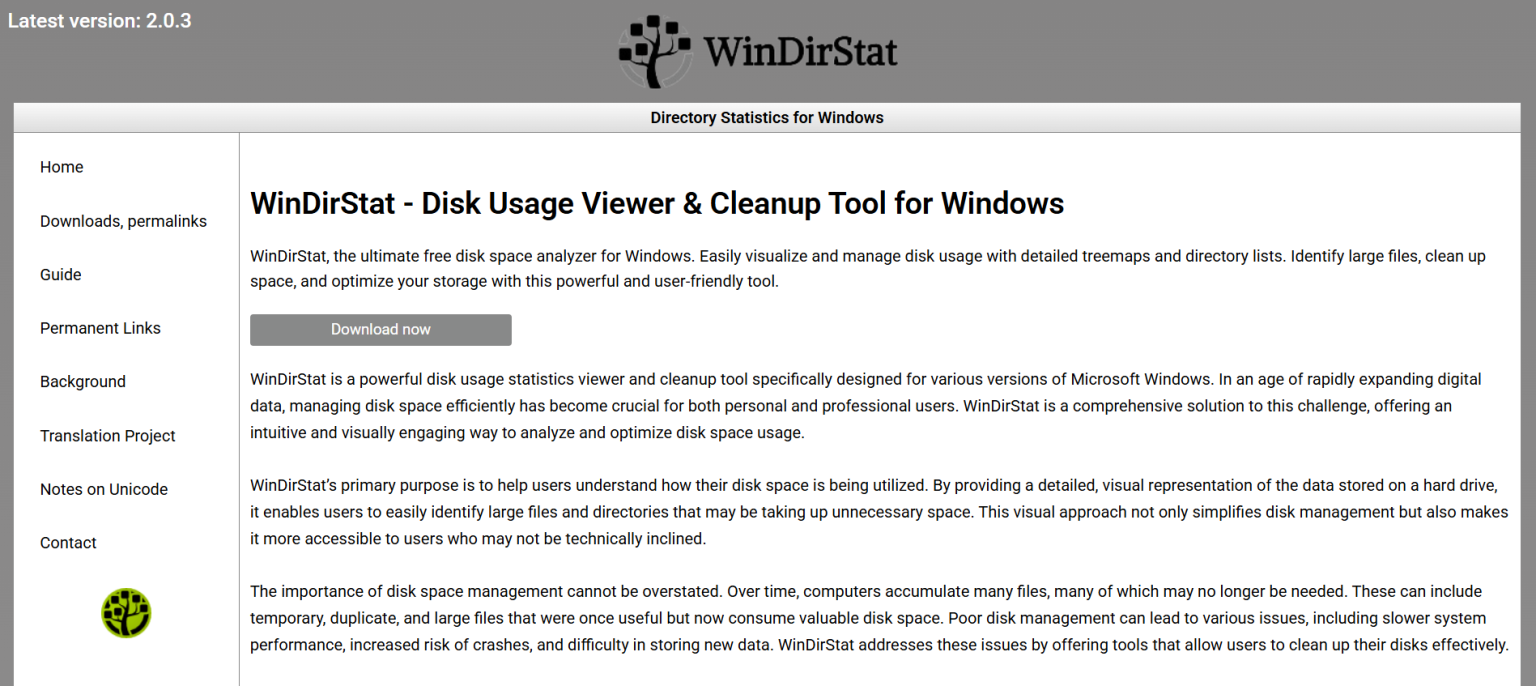Disk space doesn’t disappear magically — but it sure feels that way. One day your system is running smoothly, and the next you’re greeted by a low disk space warning. That’s where disk analyzers come in, and WinDirStat stands tall as a favorite among Windows users. It’s not just about finding large files — it’s about understanding how your storage is structured, what’s hogging space, and how you can clean things up efficiently.
Among the many tools available, WinDirStat continues to dominate because of its intuitive interface, visual treemap, and robust functionality — all packed into a lightweight, open-source package. Let’s explore what makes it the best disk analyzer for Windows users, and why it has maintained its relevance for over a decade.
Origins Rooted in Open-Source Philosophy
WinDirStat, short for Windows Directory Statistics, was developed by Bernhard Seifert and Oliver Schneider. Inspired by KDirStat, a similar program for Linux, the team wanted to bring the same capabilities to Windows users. From its inception, WinDirStat embraced the open-source model. This means it’s completely free, regularly improved by a community of developers, and transparent in how it works.
Many commercial alternatives lock advanced features behind paywalls. WinDirStat does the opposite — it provides everything upfront with zero cost. That freedom has helped build a loyal community around it, particularly among power users, IT professionals, and developers.
Visualizing Data with Treemaps
What sets WinDirStat apart visually is its iconic treemap. When a scan completes, you’re presented with a mosaic of colored rectangles — a map of your storage space. Each block represents a file, and the size of the block correlates with the file’s actual size on your disk.
Colors distinguish file types, so a quick glance reveals:
- Large video files
- Hidden cache folders
- Obsolete backups
- Gigantic ISO files forgotten in Downloads
No guesswork required — the treemap transforms abstract storage space into something tangible and easy to interpret. For many users, this visual clarity is the first “aha!” moment with WinDirStat.
Unmatched Simplicity and Speed
Some disk analyzers throw a kitchen sink of features at you, bloating their UI and slowing down performance. WinDirStat goes the other way — its interface remains clean, focused, and minimal. From installation to scan completion, the process is fast, seamless, and non-invasive.
You launch the app, select a drive or folder, and the software gets to work. Within moments, it provides a comprehensive breakdown of all disk usage. It doesn’t just look at files either — it dives into folders, subdirectories, hidden items, and system content.
This simplicity translates to speed. Even on older hardware, WinDirStat completes scans quickly and efficiently without dragging down system resources.
Deep Dive into File Types
Above the treemap lies the file extension list, showing what types of files dominate your storage. Each entry includes:
- Extension name (e.g., .mp4, .exe, .zip)
- Total size
- Percentage of disk usage
- File count
It’s one thing to know a file is large — it’s another to understand trends. Maybe you’re unknowingly hoarding large .log files, or you’ve got a growing collection of raw photos. The breakdown helps users make informed cleanup decisions.
This feature is especially useful for developers, designers, and video editors who regularly work with large media files. It also helps identify junk files that silently accumulate over time.
Bulk File Management Made Easy
Once you’ve identified the storage culprits, WinDirStat doesn’t leave you hanging. It provides a suite of management tools:
- Open file location in Explorer
- Delete files or folders
- Move items
- Launch external cleanup tools
- Explore folder structure contextually
Each action is designed to reduce friction. You don’t need to jump back and forth between File Explorer and the analyzer. Everything is handled from within the interface.
The contextual right-click menu brings familiarity to the process — making it as natural as managing files on your desktop.
Perfect for Power Users and IT Professionals
IT administrators often rely on WinDirStat for audits, client cleanups, and diagnostics. It’s portable, fast, and reveals issues hidden deep within system folders. Whether it’s rogue backup files or bloated update caches, the tool uncovers inefficiencies quickly.
Because it doesn’t modify or manipulate files automatically, it’s also safe for cautious users. There are no background services, no scheduled tasks, and no data sent back to developers. It runs when you want it, and exits cleanly when you’re done.
This low-risk profile makes it perfect for professional use in secure environments.
Compatibility Across Windows Versions
Another point in its favor — WinDirStat works on almost every modern Windows version, from XP and Vista to Windows 11. That kind of backward compatibility is increasingly rare. Whether you’re analyzing a personal laptop or a legacy enterprise server, chances are WinDirStat runs without a hitch.
This cross-compatibility has made it a default recommendation in forums, tech blogs, and repair guides. When tech support says, “Use WinDirStat to see what’s taking up space,” it’s because they trust it to work everywhere.
Lightweight Installation and Portable Version
The installer for WinDirStat is under 1MB. Compare that to bloated commercial software that requires hundreds of megabytes, system drivers, or admin privileges.
For technicians or users who prefer a non-installation approach, WinDirStat offers a portable version. Just extract the zip and run the executable. No registry edits, no background processes — perfect for flash drives or emergency diagnostic kits.
This small footprint makes it accessible in low-resource environments or when dealing with compromised systems.
Highly Rated and Trusted Globally
You’ll find WinDirStat recommended by:
- Reddit’s tech support threads
- YouTube repair channels
- Microsoft community forums
- Sysadmin guides
- University IT labs
This organic praise isn’t bought — it’s earned through years of reliability. With millions of downloads and a proven track record, it’s become a go-to disk analyzer for professionals and everyday users alike.
Security-wise, it’s also open-source, so its code is available for review. That transparency builds trust in a landscape where many cleanup tools bundle adware or invasive telemetry.
Constantly Relevant Despite Its Age
WinDirStat hasn’t changed much in recent years, but that’s part of the appeal. It’s not trying to become a system optimizer or antivirus. It focuses on doing one job exceptionally well — analyzing disk usage and helping users clean up.
While competitors try to dazzle with modern UIs or unnecessary features, WinDirStat stays grounded in utility. This minimalism ensures it stays fast, bug-free, and dependable.
That consistency is rare in a world where software often changes for change’s sake.
Real-World Use Cases
Here’s how different users benefit from WinDirStat in real-world scenarios:
- Gamers: Identify outdated install folders or massive Steam backups
- Photographers: Locate duplicate RAW files or oversized image caches
- Developers: Discover old project folders, uncompressed libraries, and unused SDKs
- Students: Free up space on school-issued laptops
- Remote workers: Identify unnecessary Zoom recordings and temp files
- IT pros: Audit client machines for storage inefficiencies
Its applications span virtually every user profile.
Zero Ads, Zero Bloat
WinDirStat doesn’t show ads. It doesn’t upsell you on premium features. It doesn’t install browser extensions, third-party apps, or performance “boosters.” It’s exactly what it says: a clean, focused utility built to do a single job exceptionally well.
In today’s cluttered software ecosystem, this purity is refreshing. No hidden monetization model. Just open-source software maintained by a passionate community.
Where to Download Safely
Always download from the official website WinDirStat or trusted repositories like GitHub or Ninite. Avoid third-party download portals that may bundle malware or modified versions.
The official site ensures you get the clean, original version without any shady add-ons.
Final Thoughts
WinDirStat remains the best disk analyzer because it combines speed, simplicity, and visual power in a way that’s still unmatched. It’s open-source, lightweight, and works on virtually any Windows machine. Whether you’re a casual user trying to free up space or a professional diagnosing disk usage problems, WinDirStat delivers.

